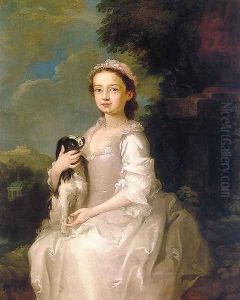Follower of William Hogarth Paintings
William Hogarth was a prominent English painter, printmaker, pictorial satirist, social critic, and editorial cartoonist who has been credited with pioneering western sequential art. His work ranged from realistic portraiture to comic strip-like series of pictures called 'modern moral subjects'. Much of his artwork reflects his keen interest in the lower and middle classes, and he depicted the social issues of his time with a satirical and moralistic edge.
Hogarth was born in London on November 10, 1697, to a lower-middle-class family. His father, Richard Hogarth, was a schoolmaster and textbook writer who faced financial difficulties during William's early life. His upbringing amidst the bustling urban life of London deeply influenced his later works which frequently addressed the city's complex social dynamics.
His artistic career began after an apprenticeship with a silver engraver, which led to his own work in trade cards and other prints. In 1720, he enrolled in the new St. Martin's Lane Academy, where he pursued his interest in painting. Over time, Hogarth rose to prominence in the London art scene, particularly through his series of 'moral' works such as 'A Harlot's Progress' (1732), 'A Rake's Progress' (1735), and 'Marriage A-la-Mode' (1743–1745).
These narrative series were published as engravings and became widely popular, often featuring a satirical and moral critique of the upper classes, the follies of arranged marriage, and the vices of the era. These works were influential in defining a new form of pictorial storytelling, with a clear narrative thread that could be followed across several images.
Aside from these narrative series, Hogarth also produced individual prints and paintings. His famous print, 'Gin Lane' (1751), is a stark and morbid depiction of the effects of gin consumption on the poor of London. Additionally, his portrait work was highly regarded, and he painted many notable figures of his time.
In 1753, Hogarth wrote his book 'The Analysis of Beauty', in which he attempted to define the principles of beauty and art in a more scientific way. He argued for the 'line of beauty', a serpentine line that he believed embodied a pleasing aesthetic.
William Hogarth died in London on October 26, 1764. His legacy was significant, as he left behind a body of work that continues to be studied and appreciated for its artistic quality and its sharp commentary on 18th-century British society. The term 'Follower of William Hogarth' refers to artists and printmakers who were influenced by Hogarth's style and subjects, and who often produced works that reflect the same mix of satire, social criticism, and moral commentary on contemporary issues. Although these followers did not achieve the same level of fame, their works contribute to the understanding and appreciation of Hogarth's impact on art history.
